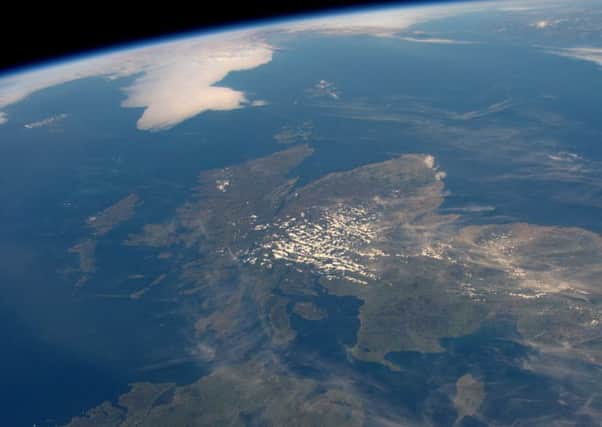Bill Jamieson: In space no one can hear us scream '˜Brexit'


What a contrast from the lurid warnings of thunderous black clouds about to burst since the Brexit vote on 23 June. Forecasts of doom and gloom ahead blocked out the sun. The economy was headed for disaster. Unemployment would rise. Consumer spending would slump. Taxes would have to rise.
Now it’s certainly true we have a far from cloudless sky. Scotland’s economy was slowing long before the Brexit vote. And we have a sluggish world economy to contend with.
Advertisement
Hide AdAdvertisement
Hide AdBut the feared Brexit cloud has failed to burst. “Claims that the vote to leave the EU would quickly result in a rapid deterioration in the economy,” Martin Beck of Oxford Economics dryly noted last week, “have not been supported by the first official data relating to the post-referendum period. July saw unemployment fall and retail sales surge.”
Across the UK, unemployment fell by 52,000 between April and June. The UK jobless total is now at its lowest for eight years, according to the Office of National Statistics, while the employment rate hit a record 74.5 per cent, with 31.8 million people in work in the three months to June – 172,000 more than the previous quarter.
But what of Scotland, where ministers have turned synchronised hand-wringing into an Olympic sport? Here too unemployment has fallen, with the number of people in employment rising by a record level.
Unemployment in Scotland fell by 26,000 between April and June while numbers in work rose by 51,000 over the same period to stand at 2,629,000 – the highest quarterly rise since records began. Scotland is also outperforming the rest of the UK on female and youth employment and unemployment rates.
And what of those warnings of a post-Brexit slump in consumer spending? Retailers across the UK sold more in July than during the same period last year. Total sales were up by 1.9 per cent. Helen Dickinson, chief executive of the British Retail Consortium, said “little has materially changed” for most UK households since the vote, so the rise was not surprising.
Scotland fared less well. While the shop vacancy rate dropped by 0.9 per cent in July to 7.5 per cent – the second lowest of any area and bucking the trend for the UK – the picture was less positive in terms of footfall. This fell by 1.9 per cent following a 3.3 per cent drop in June, poor weather being blamed for lacklustre sales of summer clothing and footwear.
What of the economy generally? UK industrial output grew at the fastest rate for 17 years in the April-to-June quarter, up 2.1 per cent compared with the first quarter. The ONS said “very few” respondents had been affected by the uncertainty from the referendum.
The construction sector is struggling, though the Mineral Products Association, which represents firms making products such as asphalt and cement, said its figures pointed to an upturn in the industry.
Advertisement
Hide AdAdvertisement
Hide AdInterest costs for business and household borrowers have been cut to an all-time low of 0.25 per cent, with other help to encourage banks to lend. And a “reset” of fiscal policy is pledged in the Autumn Statement.
Meanwhile, the UK’s tourism sector has seen a boost, with flight bookings to the UK up by 7.1 per cent in the four weeks after 23 June, as a weaker pound has made Britain a cheaper destination for overseas tourists. Passenger numbers at Scotland’s three main airports rose by 4.9 per cent in July compared with a year ago.
Now caveats abound with all of this. Manufacturers’ import costs have risen with the fall in sterling. And detailed Brexit negotiations have yet to begin. Major uncertainties lie ahead.
And economic forecasts are more doom-laden than ever. The Ernst & Young ITEM Club forecast for growth in Scotland this year is down to 1.2 per cent. Even gloomier is the Fraser of Allander Institute. It has slashed its forecast for this year to 0.9 per cent, with a recession-skirting slowdown to just 0.5 per cent for 2017.
Compared with these, Inverness-based economist Tony Mackay is a stand-out. His inestimable monthly reports provide a comprehensive summary of key Scottish business developments. He is currently forecasting growth of 1.6 per cent for this year, 1.8 per cent for 2017 and two per cent for 2018.
He says the growth downgrades have been overdone and comments that “there is a lot of ‘hype’ at the present time about the negative impacts of Brexit but most of that is conjecture. I find it very difficult to believe that there has been such an adverse impact to date.”
There is always a temptation in forecasting to fall victim to “group think” – all the more potent with snapshot business confidence surveys. When these show other people are gloomy, it’s hard to go against the crowd.
In this environment, it’s easy to overlook the positive developments over the past month: GSK investing £110 million in its Montrose factory, Tunnock’s expanding its Uddingston factory and the £20m investments by David Lloyd Leisure.
Advertisement
Hide AdAdvertisement
Hide AdOther positive developments included North Lanarkshire Council’s announcement of plans to build 1,000 more homes in the area for social rent. And in the North Sea sector, we have had the oil discovery by Premier Oil on their Bagpuss prospect in the Outer Moray Firth and Statoil submitting a development plan for its Utgard gas/condensate discovery.
And here, finally, is another break in those doom-laden clouds. The price of Brent crude touched $51.19 a barrel last week, its highest since the EU referendum. The 11 per cent surge over the week was sparked by renewed hopes that an upcoming meeting of oil exporters could ease production levels to prop up prices.
The sky may be far from cloudless. But forecasts of a Brexit thunderclap have proved wide of the mark.